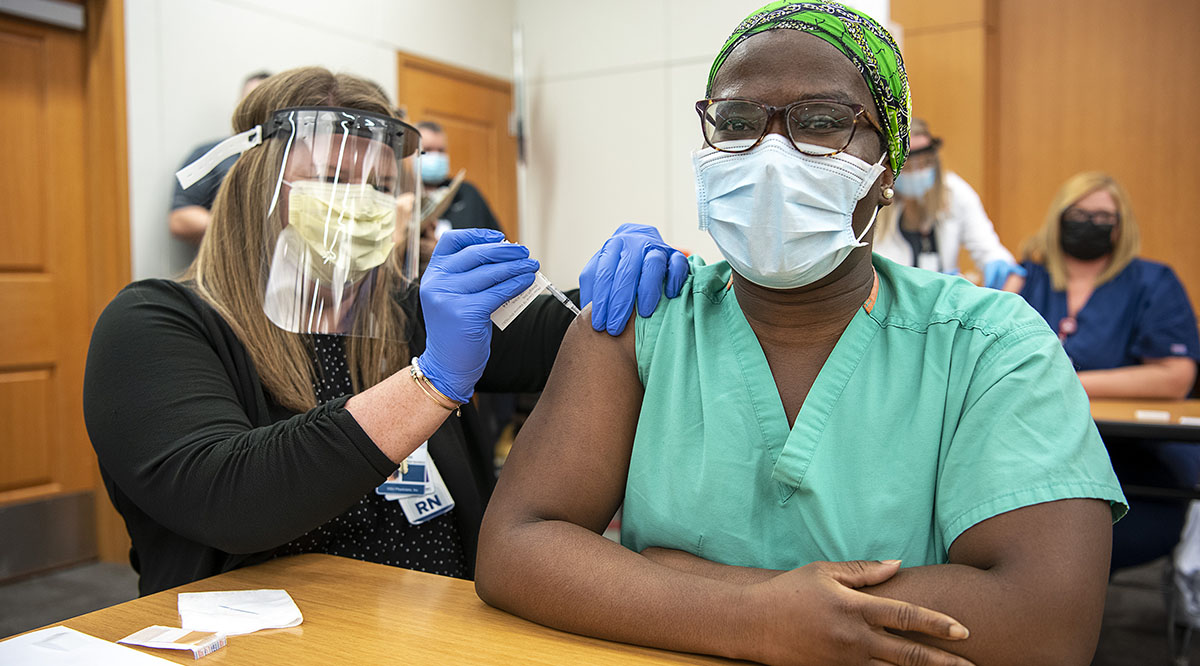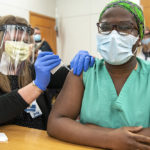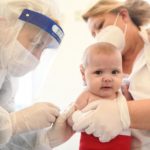Are the vaccines safe? Can vaccinated people spread the virus? Can hospitals mandate inoculation? Amid hope and anxiety, workers seek these answers and more.
Excited. Relieved. Skeptical. Scared.
Those are some of the feelings being expressed by health care workers across the country as they stand at the front of the line for the first vaccines against COVID-19, envisioning victory against a disease that has physically and emotionally drained them like nothing before.
“Finally, there is hope,” said Gabor Kelen, MD, director of emergency medicine at Johns Hopkins Medicine in Baltimore, Maryland.
But like everything connected with COVID-19, even hope comes with questions and anxiety.
“By and large, staff are excited and keen to be vaccinated,” said Marlene Millen, MD, chief medical information officer for ambulatory care at the University of California (UC), San Diego, School of Medicine. “There are lots of questions, as there would be for any new vaccine.”
“I thought here would be universal excitement, but there is a lot of hesitation” among health workers, said Taison Bell, MD, director of the medical intensive care unit at UVA Health in Charlottesville, Virginia.
As the first federally-approved vaccine, developed jointly by Pfizer and BioNTech, arrived in hospitals this week, while another, developed by Moderna, moves toward deployment any day now, the feelings of hospital staff about getting inoculated fall into three broad categories, Kelen said: early adopters who display a “Send me in, Coach” enthusiasm about getting their shots; wary thinkers who want more answers and to see how the vaccine affects others first; and skeptics who are not convinced the vaccines will be safe and effective.
Bell is a “Send me in, Coach” type: He got vaccinated on Dec. 15, and before that, he launched a campaign on Twitter to educate people about the vaccines and share his experience. Hospitals are running their own education initiatives for staff. At Johns Hopkins, Kelen said, the main message is hope: “You’re tired of masking. You’re tired of seeing patients die. You’re wearing down. Just hang in there for a few months longer.”
Are they safe?
The Food and Drug Administration (FDA) is approving the first COVID-19 vaccines under emergency use authorizations (EUAs) rather than by issuing full licenses, which would require longer testing and approval processes to study their safety and effectiveness. The FDA grants EUAs only for public health emergencies (as it did for Ebola and Middle East respiratory syndrome [MERS], among other diseases) and states that its primary criteria is to “determine that the known and potential benefits outweigh the known and potential risks of the vaccine.”
“For this EUA, the FDA required significantly more data on safety and efficacy than usual,” said Janis Orlowski, MD, chief health care officer at the AAMC.
Regarding the benefits: The FDA reported that each vaccine was about 95% effective in stopping people in the trials from contracting COVID-19. As of Dec. 1, COVID-19 had stricken about 245,000 health care workers and was associated with the deaths of 858, according to the Centers for Disease Control and Prevention (CDC).
As for risks, Pfizer and Moderna say no serious health problems were reported by the tens of thousands of people who received their vaccines during clinical trials. The most common side effects — fatigue, headaches, chills, and muscle pain — lasted about one day and most often occurred after the second dose. Since the vaccine rollout began in the U.K. and U.S., there have been sporadic reports of severe reactions in people with histories of significant allergic reactions to some foods and drugs.
“Forty to 50 percent of people might feel ill after the second shot, including low grade fevers and muscle aches,” Orlowski said.
People “should not be alarmed” by the side effects, Millen said. “The reactions are a sign the vaccine is prompting an immune response.”
The Pfizer and Moderna vaccines do not contain any part of the virus, which removes one of the risks posed by vaccines against other viruses. Instead, they use genetic molecules, called messenger RNA (mRNA), that slip into cells and set off a series of processes that stimulate the body’s immune system to attack the coronavirus. The cell degrades the mRNA and there is no evidence that it remains in the cells, Orlowski said. Here is a detailed explanation.
AAMC President and CEO David J. Skorton, MD, issued a statement noting that mRNA vaccines were “made possible by decades of biomedical research within the academic medicine community.”
Lynn Combs, medication procurement coordinator at the University of Virginia Medical Center Pharmacy, unpacks the first shipment of COVID-19 vaccines for storage in a freezer set at minus 70 degrees Celsius.
Lynn Combs, medication procurement coordinator at the University of Virginia Medical Center Pharmacy, unpacks the first shipment of COVID-19 vaccines for storage in a freezer set at minus 70 degrees Celsius.
Credit: Sanjay Sanchak, University of Virginia
Who decides who gets vaccinated first?
The trickle-down prioritization process starts with guidance at the federal level, runs through state and local agencies, and ends with implementation by health care institutions.
The CDC’s Advisory Committee on Immunization Practices (ACIP), composed of medical and public health experts, issued guidelines for states to allocate the COVID-19 vaccines, giving health care workers and residents of long-term care facilities top priority.
The states used that and other guidance from the CDC and the National Academies of Science, Engineering, and Medicine to develop plans for which categories of health care workers and long-term care residents receive the vaccines and through several phases. Here is each state’s basic plan. Health care institutions use those plans to identify which specific staff get vaccinated and in what order.
Who is a ‘health care worker’?
The term covers just about anyone whose job assignment puts them at high risk of exposure to the coronavirus. The ACIP defines “health care personnel” as paid or unpaid workers “who have the potential for direct or indirect exposure to patients or infectious materials, including body substances; contaminated medical supplies, devices, and equipment; contaminated environmental surfaces; or contaminated air.”
The CDC says the workers include not only medical providers but also “support staff” in areas such as food, environmental, security, and administrative services. The settings include not just hospitals, but inpatient rehabilitation facilities, long-term care facilities, home health care, vehicles where health care is delivered (e.g., ambulances and mobile clinics), and outpatient facilities (such as physician offices) as well. California’s “Tier 1” health care workers, for example, include paramedics and staff in dialysis centers.
The CDC estimates that under those definitions, there are 21 million health care workers in the United States.
Who gets priority among health care workers?
State and health system plans prioritize those who regularly work in high-risk settings for contamination, including emergency rooms, COVID-19 wards, maternity wards, and intensive care units with COVID-19 patients. Health systems are typically offering the vaccine to all staff who work in those areas.
“It’s amazing how many people are on the front lines — who are so indispensable that if they get sick [from the virus], it’s a hardship for everyone else or it’s even a showstopper,” Kelen said.
Because there probably won’t be enough vaccine in the first rounds to cover the front-line workers at most health care facilities, states and hospitals are using various criteria and strategies to establish the initial order. These include:
Health conditions: Some states, such as Tennessee and California, prioritize staff who might be more susceptible to severe harm from the disease because of health conditions — including cancer, chronic renal disease, obesity, organ transplants, heart failure, and liver disease — or advanced age.
Hospital capacity: Hospitals that have the ultra-low temperature (ULT) refrigeration units that are required to store the Pfizer vaccine at minus 70 degrees Celsius are getting the lion’s share of the initial doses, which means their workers might be more likely to get the vaccines sooner than workers in other facilities. Florida, for example, chose five hospitals with ULT units, including the University of Florida (UF) Health Shands Hospital in Gainesville and UF Health Jacksonville. (The Moderna vaccine must be stored at minus 20 degrees Celsius, which standard freezers can reach.)
Hospital caseload: Some states are sending most of their first allotments to the hospitals with the most COVID-19 cases. Utah chose five such hospitals, including the University of Utah Hospital.
Random selection: To remove concerns about favoritism in the assignments, some systems, such as Johns Hopkins, used a randomized process to create lists of staff in the initial tiers who can get the vaccines on certain dates.
Staggered shots: In order to minimize the risk that a large part of any one unit will be simultaneously knocked out of action by side effects from the vaccine, many health systems are dividing the staff in those units into groups to be vaccinated on different days.
When will there be enough vaccine for all health care workers?
Probably not until at least February or March, Orlowski said. She estimated that more than 10 million health care workers might get vaccinated in the initial phases, based on the doses that Pfizer and Moderna say they can provide in the first couple of months, the need for each person to get two doses, and the federal priority on first inoculating both health care workers and residents and staff in long-term care facilities (such as nursing homes).
Can vaccinated workers forgo coronavirus precautions?
No. Although the leading vaccines appear to prevent onset of COVID-19 in the vast majority of people who get them, that protection is not 100%, and it’s unclear if a vaccinated person can spread the virus to others.
“As patients, we think, ‘If I’m vaccinated, I can’t infect you,’ but in this case, we don’t know,” Orlowski said. “We should continue to wear masks and use social distancing until more information is available.”
In addition, it’s unclear how long the immunity from vaccination lasts. Because of the high-speed nature of the trials and approvals, the people inoculated in those trials have been free of the disease for only a few months — a shorter period than the usual measurement for vaccine trials. The protection will probably last for several years but “not decades,” so people might need booster shots, Paul Offit, MD, director of the Vaccine Education Center at Children’s Hospital of Philadelphia, said during a webinar hosted by the Poynter Institute this week.
Should people get vaccinated if they’ve been infected with the COVID-19 virus?
Yes, but the ACIP suggests that those workers wait for at least 90 days from when they had the virus, so that vaccines can go to health workers who have not been infected and therefore might be more vulnerable. “Current evidence suggests reinfection is uncommon” for at least three months, the CDC says.
At UC San Diego, Millen said, “We are advising previously infected employees that it is reasonable to wait and get vaccinated after 90 days … because current research suggests people develop some natural, temporary immunity” after catching the virus.
Millen stressed, however, that it’s unclear how long that immunity lasts, and she notes that some COVID-19 survivors have gotten reinfected.
Will the families of health care workers also get priority for vaccinations?
“My husband is asking that, too,” Patricia Stinchfield, RN, president of the National Foundation for Infectious Diseases, said with a smile during the Poynter webinar.
“We should be thinking about our health care workers’ family members, but at this point, we don’t have the supply to address it that way,” said Stinchfield, who specializes in infectious diseases and vaccines at Children’s Minnesota. She said health care workers will have to continue taking precautions at home to protect others even after getting vaccinated.
What happens if someone doesn’t get the second shot?
Pfizer’s vaccine requires that people get a second shot about three weeks after the first one. Moderna’s time frame is four weeks. It’s not uncommon for vaccinations to include booster shots. Several of the COVID-19 vaccines that remain in trial stages are also based on two doses, although one from Johnson & Johnson requires only one.
People who get only the first shot probably won’t get the fullest protection, said Offit, who serves on the FDA advisory panel for approving the vaccines. American Medical Association President Susan Bailey, MD, added that getting the most protection possible is critical — not only for each individual but also to defeat the pandemic. “Being partially protected is not going to get us to herd immunity,” she said.
The hospitals that administer the vaccines are responsible for ensuring that people know when to get their second dose, “but it’s a shared responsibility” with the patients, said Kelen at Johns Hopkins.
Can an institution require employees to get vaccinated?
The federal government says they can, but it appears that they don’t want to. Orlowski said there is not yet enough real-world data about the safety and effectiveness of the vaccines to determine that everyone must take it. She added that the vaccines’ approval through an EUA rather than full FDA licensing “puts them into the realm of experimental, and therefore makes it hard to mandate.”
“That aggressive stance initially would be interpreted by a lot as confrontational,” said Bell, who serves on a committee that sets protocols for the vaccinations at UVA Health. “No one wants to feel like someone else is dictating what to put in their bodies.”
Will vaccinated staff have to take on more front-line work?
Vaccinated staff might be asked to take on more of the front-line work at first, Orlowski said, “but this should not be a long-term strategy. All health care workers need to continue their work no matter what their personal decision on vaccination.”
She and Bell said that as long as unvaccinated workers take precautions against the virus, such as properly wearing personal protective equipment, they should be able to continue working with all patients.



